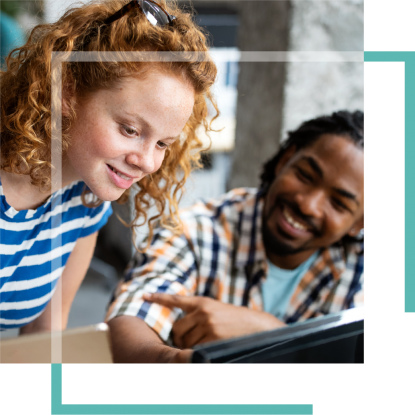
Harnessing Innovation
Individuals with Invisible Disabilities at Work
When not all disabilities are visible, empowering those with invisible disabilities means unravelling stereotypes to fully engage with the cycles of constraint that limit self-identification.
In this article, we draw upon a range of research, including our own to illustrate the innovative impact of individuals with disabilities, and present accountability processes that enable individuals to reach their full potential.
Introduction
Disabled individuals in the workplace are an under-represented and under-valued source of talent that offer a plethora of unique benefits, one of which being innovative thinking. Whilst 3.2% of disabled employees self-identify as having a disability to their employers, an overwhelming 30% of the professional workforce live with disabilities unbeknownst to work.
This anonymity is facilitated by the fact that 62% of employees with undisclosed disabilities have an invisible disability. The burden of masking an authentic self at work for individuals with invisible disabilities can culminate in increased stress and underestimated performance generating an unseen culture of dismissal.
At a time where remote work has dramatically increased isolation, disabling stereotypes to harness the innovative power of those with invisible disabilities is all the more integral.
Innovative Impact
At 10x, as part of our development phase we collected data on the validity of our personality assessments across a varied population, including individuals who self-identified as disabled.
Our research found that candidates with disabilities had higher ratings on certain facets within the scale of ‘Social Intelligence’, as well as ‘Innovation’ where candidates with disabilities had higher scores for ‘Conceptualization’ (forming creative and unique theories and ways of thinking), as well as ‘Unconventionality’ (preferring unconventional methods and solutions that challenge the norm’.
“Disability creates a constraint, and embracing constraints spurs inventive solutions.”
Haben Girma, a Disability Rights Activist and the first Deaf-Blind Graduate of Harvard Law. Financial Times.
Investing in diversity in the case of disability means investing in a lifetime of adaptability and flexibility, and empowering that individual to channel their every-day innovation into a successful career.
Our research is bolstered by results from an international study led by The Centre for Talent Innovation, where 75% of disabled employees developed value-generating concepts and ideas for their organizations, with 48% of those ideas targeting disability markets.
Disabled voices allow organizations to engage with consumer insight through an additional perspective improving employee engagement and often enabling substantial monetary benefits.
Accountability
Creating an inclusive space for disabled individuals means actively engaging with the cycles that might limit their potential.
Pressures to appear able-bodied impact 84% of disabled individuals in the workplace, with the consequent fatigue potentially feeding into employer’s impressions on competency, resulting in 63% of individuals with disabilities feeling stalled in their careers.
When recognising the value of an alternative perspective, it is integral to note the personal experience behind the innovation.
Valuing Individuals
Research from Harvard University indicates that it is not enough to tailor roles that centre around idea-generation and compact the utility of disabled employees. Equally it is not enough to blankly hire candidates that fit a diversity quota – carving out relevant and effective employee plans that suit candidates as individuals is integral.
“Companies need open and explicit discussion of how differences can be used as sources of individual and organizational effectiveness”
David Thomas and Robin Ely, Harvard Business Review
Sending Positive Signals
Fostering a culture of self-awareness extends outside of a superficial hiring process, and merges with company interactions and organization.
Creating open conversations and encouraging internal advocates to voice their disability journey legitimizes flexible processes that fully enable and encourage individuals with disabilities to thrive at work.
Failing to adequately adapt and prioritize as an organisation means forgoing the benefits of a diverse workforce, with inhibited hiring of disabled candidates contributing to ongoing economic deprivation and a tremendous waste of potential.
Leading By Example
Our Solutions focus on highlighting individual employee competencies and skill sets through our industry-leading psychometric assessments. By referring to the data, employers can pinpoint motivators, competencies and abilities outside of their personal bias, allowing disabled individuals who may be caught in a cycle of social fatigue an opportunity to shine through.
At 10x, we support organizations using 10x Hire, and recruitment consultants using 10x Talent, in holistically succeeding from the outset of initially hiring candidates through to supporting their development in a tailored and impactful way using 10x Optimize.
Unlike alternative personality assessments that include hypothetical or vague questions, the assessments used at 10x have been rigorously developed to be as simple and relevant as possible, only measuring traits that are specific and predictive of successful performance in a particular role.
This enables individuals with invisible disabilities such as autism or learning disabilities, to benefit from short, culturally neutral items without colloquialisms and idioms that may be stressful to comprehend under time constraint. Furthermore, our items have been specifically developed to be clear and direct – with no hidden meanings or trick questions.
Integrating these aspects as key components of our software means inherently catering to a diverse range of candidates whilst prioritising and valuing the right individual for the right job.
We believed there was a better way and now we know there is a better way.


Invisible Disabilities at Work – Harnessing Innovation
When not all disabilities are visible, empowering those with invisible disabilities means unravelling stereotypes to fully engage with the cycles of constraint that limit self-identification.
In this article, we draw upon a range of research, including our own to illustrate the innovative impact of individuals with disabilities, and present accountability processes that enable individuals to reach their full potential.
Introduction
Disabled individuals in the workplace are an under-represented and under-valued source of talent that offer a plethora of unique benefits, one of which being innovative thinking. Whilst 3.2% of disabled employees self-identify as having a disability to their employers, an overwhelming 30% of the professional workforce live with disabilities unbeknownst to work.
This anonymity is facilitated by the fact that 62% of employees with undisclosed disabilities have an invisible disability. The burden of masking an authentic self at work for individuals with invisible disabilities can culminate in increased stress and underestimated performance generating an unseen culture of dismissal.
At a time where remote work has dramatically increased isolation, disabling stereotypes to harness the innovative power of those with invisible disabilities is all the more integral.
Innovative Impact
At 10x, as part of our development phase we collected data on the validity of our personality assessments across a varied population, including individuals who self-identified as disabled.
Our research found that candidates with disabilities had higher ratings on certain facets within the scale of ‘Social Intelligence’, as well as ‘Innovation’ where candidates with disabilities had higher scores for ‘Conceptualization’ (forming creative and unique theories and ways of thinking), as well as ‘Unconventionality’ (preferring unconventional methods and solutions that challenge the norm’.
“Disability creates a constraint, and embracing constraints spurs inventive solutions.”
Haben Girma, a Disability Rights Activist and the first Deaf-Blind Graduate of Harvard Law. Financial Times.
Investing in diversity in the case of disability means investing in a lifetime of adaptability and flexibility, and empowering that individual to channel their every-day innovation into a successful career.
Our research is bolstered by results from an international study led by The Centre for Talent Innovation, where 75% of disabled employees developed value-generating concepts and ideas for their organizations, with 48% of those ideas targeting disability markets.
Disabled voices allow organizations to engage with consumer insight through an additional perspective improving employee engagement and often enabling substantial monetary benefits.
Accountability
Creating an inclusive space for disabled individuals means actively engaging with the cycles that might limit their potential.
Pressures to appear able-bodied impact 84% of disabled individuals in the workplace, with the consequent fatigue potentially feeding into employer’s impressions on competency, resulting in 63% of individuals with disabilities feeling stalled in their careers.
When recognising the value of an alternative perspective, it is integral to note the personal experience behind the innovation.
Valuing Individuals
Research from Harvard University indicates that it is not enough to tailor roles that centre around idea-generation and compact the utility of disabled employees. Equally it is not enough to blankly hire candidates that fit a diversity quota – carving out relevant and effective employee plans that suit candidates as individuals is integral.
“Companies need open and explicit discussion of how differences can be used as sources of individual and organizational effectiveness” – David Thomas and Robin Ely, Harvard Business Review
Sending Positive Signals
Fostering a culture of self-awareness extends outside of a superficial hiring process, and merges with company interactions and organization.
Creating open conversations and encouraging internal advocates to voice their disability journey legitimizes flexible processes that fully enable and encourage individuals with disabilities to thrive at work.
Failing to adequately adapt and prioritize as an organisation means forgoing the benefits of a diverse workforce, with inhibited hiring of disabled candidates contributing to ongoing economic deprivation and a tremendous waste of potential.
Leading By Example
Our Solutions focus on highlighting individual employee competencies and skill sets through our industry-leading psychometric assessments. By referring to the data, employers can pinpoint motivators, competencies and abilities outside of their personal bias, allowing disabled individuals who may be caught in a cycle of social fatigue an opportunity to shine through.
At 10x, we support organizations in holistically succeeding from the outset of initially hiring candidates using 10x Hire, and recruitment consultants using 10x Talent, through to supporting their development in a tailored and impactful way using 10x Optimize.
Unlike alternative personality assessments that include hypothetical or vague questions, the assessments used at 10x have been rigorously developed to be as simple and relevant as possible, only measuring traits that are specific and predictive of successful performance in a particular role.
This enables individuals with invisible disabilities such as autism or learning disabilities, to benefit from short, culturally neutral items without colloquialisms and idioms that may be stressful to comprehend under time constraint. Furthermore, our items have been specifically developed to be clear and direct – with no hidden meanings or trick questions.
Integrating these aspects as key components of our software means inherently catering to a diverse range of candidates whilst prioritising and valuing the right individual for the right job.

We'd love to talk.
Our team of experts are here to help and answer any questions you might have. Complete the form below and we will be sure to get back to you as soon as possible.